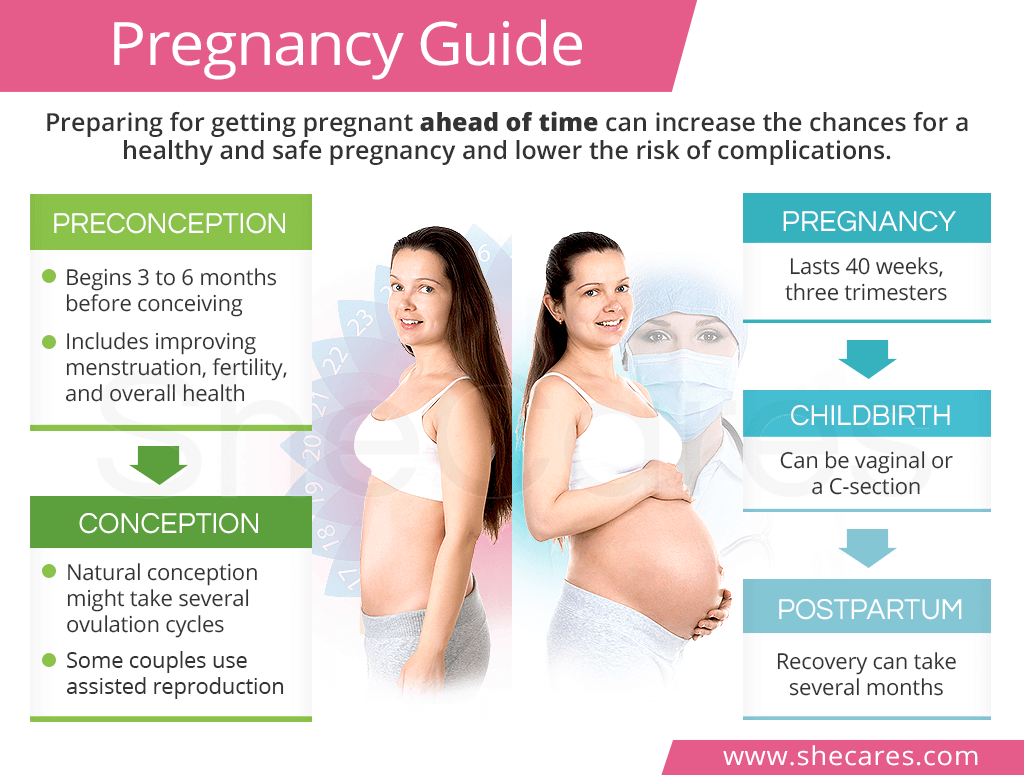Pre-Pregnancy
Preconception care is an essential part of pregnancy preparations. It is your chance to strengthen your body and mind and bring them to their optimal health before you conceive. Pre-pregnancy planning can also lower the risk of potential complications during pregnancy, like a miscarriage or premature birth, as well as help you prepare for getting pregnant after difficulties, such as ectopic pregnancy.
Ideally, a woman should start preparing to get pregnant three to six months before actually trying to conceive. Although this process might vary to from woman to woman, it can involve the following:
- Regulating menstrual cycle
- Improving ovulation
- Managing fertility
- Controlling chronic conditions, such as diabetes, obesity, or polycystic ovary syndrome (PCOS)
These preconception goals can be achieved with the help of prenatal vitamins and herbal supplements, a well-balanced diet, regular exercise, and other wholesome habits, all of which can ensure successful conception and a healthy pregnancy.
Keep on reading for more information on preparing for pregnancy or continue to the next section to learn more about conception.
Conception
Some couples get pregnant on the first attempt while for others trying for a baby might take several menstrual cycles. However, most couples do conceive within 12 cycles with 70% succeeding within three months.
Understanding how conception works can be useful in realizing the importance of various factors that can affect conception and make it possible. This includes learning effective ways to increase chances of getting pregnant, from a fertility diet to best sex positions.
Assisted Reproductive Technologies (ARTs)
For those couples that suffer from infertility or other conditions that might compromise their conception efforts, there are a number of ARTs. With their help, many women of various ages or health statuses can realize their dream of having a baby. The most common ARTs include:
Continue reading to learn more about trying to conceive or proceed to the next section to discover more information about pregnancy.
Pregnancy
Pregnancy, also called gestation, typically spans over the period of about 40 weeks, counting from the first day of the last period. The course of pregnancy is divided into three trimesters, each with distinct characteristics and fetal development milestones.
- First trimester: weeks 0 to 12
- Second trimester: weeks 13 to 27
- Third trimester: weeks 28 to 40
Pregnancy Tests
There are a number of pregnancy tests that a woman can take at home or at a medical facility to confirm her gestation, including urine tests or blood tests that detect the presence of human chorionic gonadotropin (hCG).
Pregnancy Signs and Symptoms
Women typically experience a number of pregnancy signs and symptoms, especially in early pregnancy, which might include the following:
- Fatigue
- Nausea
- Mood swings
- Unusual food cravings
High-risk Pregnancy
Some mothers-to-be go through what is called a high risk pregnancy because of an increased likelihood of possible complications, including gestational diabetes or preeclampsia. Risk factors that might mandate additional care include:
- Pregnancy at advanced maternal age
- Pre-existing maternal conditions
- Multiple gestation
Fortunately, with healthy pregnancy tips, such as keeping a nutritious pregnancy diet or reducing stress during pregnancy, aspiring mothers can effectively lower those risks.
Childbirth
A healthy, full-time pregnancy typically results in a childbirth between 39 weeks and 40 weeks, 6 days. In emergency cases when the baby's life is in danger, an extremely preterm birth can occur even as early as at 28 weeks. After 42 weeks, the pregnancy is overdue, and the labor has to be induced to prevent serious complications.
Signs of Labor
The signs of labor, such as contractions or breaking of the waters, are very characteristic and easily recognizable. There are three stages of labor, which can span over several hours:
- Contractions
- Birth of the baby
- Delivery of the placenta
Types of Birth
The most common child delivery methods include a natural birth and a Cesarean section.
Besides giving birth at the hospital, women often choose alternative birthing methods, such as home or water birth, each with their own advantages and disadvantages.
Mothers-to-be also have a variety of birthing classes at their disposal, where they can learn various techniques and birthing positions to help them through the delivery.
Postpartum
The term postpartum refers to the time following childbirth, which is divided in three phases that can span over a period of six months. The most crucial, however, are the first six to 12 hours immediately after giving birth, during which a number of potentially-dangerous postpartum complications might arise concerning the mother's health.
Postpartum Symptoms
As women recuperate after pregnancy and birth and try to withhold the demands of motherhood, they can experience a variety of postpartum symptoms. The most common ones include:
- Higher risk of infections
- Postpartum hemorrhage
- Weight loss problems loss
- Self-confidence issues
- Postpartum depression
Postpartum Depression
Postpartum depression is a serious post-pregnancy challenge for new mothers is. It is characterized by strong feelings of sadness, overwhelming fatigue, and persistent anxiety, all of which can make it hard for women to care for their babies and themselves.
Postpartum Recovery
A typical postpartum recovery might take several months and varies greatly from woman to woman. It is essential to a woman's overall health, both physical and mental, as well as potential subsequent pregnancies.
Conclusions
Without a doubt, the process of conceiving a baby is a time of numerous physiological and psychological changes. Besides extensive scientific information about the biological mechanisms behind human reproduction, pregnancy remains perceived as a miracle of life. It is, therefore, worth dedicating all your efforts to preparing for your pregnancy ahead of time. Using the recommendations included in our pregnancy guide will enable you to go through this life-changing journey in the most optimal and wholesome way for the sake of your and your baby's well-being.
Sources
- American Pregnancy Association. (2018). Getting Pregnant. Retrieved July 2, 2018 from http://americanpregnancy.org/getting-pregnant/
- American Psychological Association. (2018). Postpartum Depression. Retrieved July 2, 2018 from http://www.apa.org/pi/women/resources/reports/postpartum-depression.aspx
- CDC. (2018). Pregnancy. Retrieved July 2, 2018 from https://www.cdc.gov/pregnancy/index.html
- Childbirth Connection. (2018). Healthy Pregnancy. Retrieved July 2, 2018 from http://www.childbirthconnection.org/healthy-pregnancy/
- Health Direct. (n.d.). Pregnancy, Birth and baby. Retrieved July 2, 2018 from https://www.pregnancybirthbaby.org.au/
- Mayo Clinic. (2016). How to get pregnant. Retrieved July 2, 2018 from https://www.mayoclinic.org/healthy-lifestyle/getting-pregnant/in-depth/how-to-get-pregnant/art-20047611
- Medline Plus. (2018). Childbirth. Retrieved July 2, 2018 from https://medlineplus.gov/childbirth.html
- Planned Parenthood. (2018). Pre-pregnancy Health. Retrieved July 2, 2018 from https://www.plannedparenthood.org/learn/pregnancy/pre-pregnancy-health
- Office on Women's Health. (2018). Pregnancy. Retrieved July 2, 2018 from https://www.womenshealth.gov/pregnancy
- University of Minnesota. (n.d.). How has childbirth changed in this century) Retrieved July 2, 2018 from https://www.takingcharge.csh.umn.edu/explore-healing-practices/holistic-pregnancy-childbirth/how-has-childbirth-changed-century
- US Food & Drug Administration. (2018). Pregnancy. Retrieved July 2, 2018 from https://www.fda.gov/ForConsumers/ByAudience/ForWomen/WomensHealthTopics/ucm117976.htm


